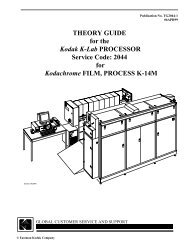KODAK T-MAX Professional Films - 125px
KODAK T-MAX Professional Films - 125px
KODAK T-MAX Professional Films - 125px
You also want an ePaper? Increase the reach of your titles
YUMPU automatically turns print PDFs into web optimized ePapers that Google loves.
ADJUSTING FILM CONTRAST<br />
If you want to increase or decrease film contrast from its<br />
normal value, you can adjust your standard development<br />
time. Your standard development time is the time that<br />
produces normal negative contrast based on your processing<br />
equipment and conditions, agitation, and processing<br />
technique.<br />
The table below provides adjustment factors for several<br />
developers. The factors are based on a developer<br />
temperature of 75°F (24°C) for <strong>KODAK</strong> T-<strong>MAX</strong><br />
Developers and a temperature of 68°F(20°C) for the others.<br />
The “standard” for each developer is indicated by 1.0. To<br />
increase or decrease film contrast or to use a different<br />
developer temperature, find the adjustment factor in the<br />
table. Multiply the standard development time by this factor<br />
to find the development time to use for a different contrast or<br />
developer temperature (or both).<br />
For detailed processing instructions for <strong>KODAK</strong> XTOL<br />
Developer, see <strong>KODAK</strong> XTOL Developer, <strong>KODAK</strong><br />
Publication No. J-109.<br />
Note: These tables apply to negatives you will print with a<br />
diffusion enlarger. If you use a condenser enlarger, shift your<br />
selection one column to the left.<br />
Temperature<br />
NR = Not recommended<br />
Development-Time Adjustment Factors<br />
20% Less<br />
Contrast<br />
Normal<br />
Contrast<br />
20% More<br />
Contrast<br />
40% More<br />
Contrast<br />
<strong>KODAK</strong> T-<strong>MAX</strong> Developer and<br />
T-<strong>MAX</strong> RS Developer and Replenisher<br />
68°F (20°C) 0.9 * 1.2 1.4 NR<br />
72°F (22°C) 0.8 * 1.1 1.3 1.7<br />
75°F (24°C) 0.7 * 1.0 1.2 1.5<br />
<strong>KODAK</strong> Developer D-76 and MICRODOL-X Developer<br />
65°F (18°C) 1.0 * 1.2 1.4 1.6<br />
68°F (20°C) 0.8 * 1.0 1.2 1.4<br />
70°F (21°C) 0.7 * 0.9 1.1 1.3<br />
72°F (22°C) 0.7 * 0.8 1.0 1.2<br />
75°F (24°C) 0.6 * 0.7 0.9 1.0<br />
<strong>KODAK</strong> HC-110 Developer (Dil B)<br />
65°F (18°C) 0.7 * 1.2 1.6 2.1<br />
68°F (20°C) 0.6 * 1.0 1.4 1.8<br />
70°F (21°C) 0.6 * 0.9 1.3 1.6<br />
72°F (22°C) 0.5 * 0.8 1.2 1.5<br />
75°F (24°C) 0.4 * 0.7 1.0 1.3<br />
<strong>KODAK</strong> MICRODOL-X Developer (1:3)<br />
75°F (24°C) 0.8 * 1.0 1.3 1.5<br />
* If you select one of these factors, increase camera exposure by one<br />
stop.<br />
RETOUCHING<br />
You can retouch <strong>KODAK</strong> T-<strong>MAX</strong> <strong>Professional</strong> Film in 120<br />
and sheet sizes by applying liquid dyes to the base or<br />
emulsion side. You can also use retouching pencil on the<br />
base side after applying <strong>KODAK</strong> Retouching Fluid.<br />
IMAGE-STRUCTURE CHARACTERISTICS<br />
The data in this section are based on development at<br />
68°F (20°C) in <strong>KODAK</strong> Developer D-76.<br />
<strong>KODAK</strong> T-<strong>MAX</strong> 100 <strong>Professional</strong> Film<br />
Diffuse rms Granularity * 8<br />
Resolving Power †<br />
TOC 1.6:1<br />
TOC 1000:1<br />
63 lines/mm<br />
200 lines/mm<br />
<strong>KODAK</strong> T-<strong>MAX</strong> 400 <strong>Professional</strong> Film<br />
Diffuse rms Granularity * 10<br />
Resolving Power †<br />
TOC 1.6:1 50 lines/mm<br />
TOC 1000:1 125 lines/mm<br />
* Read at a net diffuse density of 1.00, using a 48-micrometre aperture,<br />
12X magnification.<br />
† Determined according to a method similar to the one described in<br />
ISO 6328, Photography—Determination of ISO Resolving Power.<br />
<strong>KODAK</strong> T-<strong>MAX</strong> <strong>Professional</strong> <strong>Films</strong> • F-32 13
















